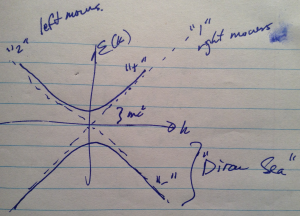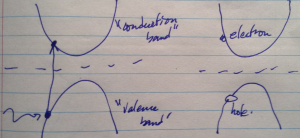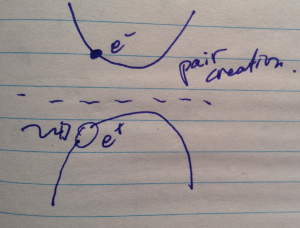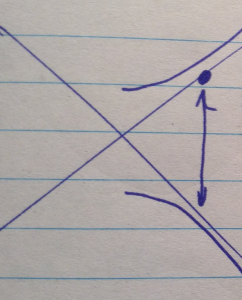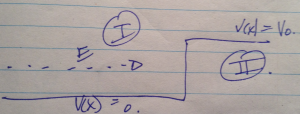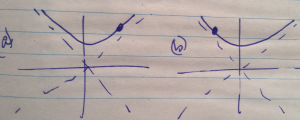[Click here for a PDF of this post with nicer formatting]
Question: Time evolution of spin half probability and dispersion ([1] pr. 2.3)
A spin \( 1/2 \) system \( \BS \cdot \ncap \), with \( \ncap = \sin \beta \xcap + \cos\beta \zcap \), is in state with eigenvalue \( \Hbar/2 \), acted on by a magnetic field of strength \( B \) in the \( +z \) direction.
(a)
If \( S_x \) is measured at time \( t \), what is the probability of getting \( + \Hbar/2 \)?
(b)
Evaluate the dispersion in \( S_x \) as a function of t, that is,
\begin{equation}\label{eqn:spinTimeEvolution:20}
\expectation{\lr{ S_x – \expectation{S_x}}^2}.
\end{equation}
(c)
Check your answers for \( \beta \rightarrow 0, \pi/2 \) to see if they make sense.
Answer
(a)
The spin operator in matrix form is
\begin{equation}\label{eqn:spinTimeEvolution:40}
\begin{aligned}
S \cdot \ncap
&=
\frac{\Hbar}{2} \lr{ \sigma_z \cos\beta + \sigma_x \sin\beta } \\
&=
\frac{\Hbar}{2} \lr{ \begin{bmatrix} 1 & 0 \\ 0 & -1 \\ \end{bmatrix} \cos\beta + \begin{bmatrix} 0 & 1 \\ 1 & 0 \\ \end{bmatrix} \sin\beta } \\
&=
\frac{\Hbar}{2}
\begin{bmatrix}
\cos\beta & \sin\beta \\
\sin\beta & -\cos\beta
\end{bmatrix}.
\end{aligned}
\end{equation}
The \( \ket{S \cdot \ncap ; + } \) eigenstate is found from
\begin{equation}\label{eqn:spinTimeEvolution:60}
\lr{ S \cdot \ncap – \Hbar/2}
\begin{bmatrix}
a \\
b
\end{bmatrix}
= 0,
\end{equation}
or
\begin{equation}\label{eqn:spinTimeEvolution:80}
\begin{aligned}
0
&=
\lr{ \cos\beta – 1 } a + \sin\beta b \\
&=
\lr{ -2 \sin^2(\beta/2) } a + 2 \sin(\beta/2) \cos(\beta/2) b \\
&=
\lr{ – \sin(\beta/2) } a + \cos(\beta/2) b,
\end{aligned}
\end{equation}
or
\begin{equation}\label{eqn:spinTimeEvolution:100}
\ket{ S \cdot \ncap ; + }
=
\begin{bmatrix}
\cos(\beta/2) \\
\sin(\beta/2) \\
\end{bmatrix}.
\end{equation}
The Hamiltonian is
\begin{equation}\label{eqn:spinTimeEvolution:120}
H
= – \frac{e B}{m c} S_z
= – \frac{e B \Hbar}{2 m c} \sigma_z,
\end{equation}
so the time evolution operator is
\begin{equation}\label{eqn:spinTimeEvolution:140}
U
= e^{-i H t/\Hbar}
= e^{ \frac{i e B t }{2 m c} \sigma_z }.
\end{equation}
Let \( \omega = e B/(2 m c) \), so
\begin{equation}\label{eqn:spinTimeEvolution:160}
\begin{aligned}
U
&=
e^{i \sigma_z \omega t} \\
&=
\cos(\omega t) + i \sigma_z \sin(\omega t) \\
&=
\begin{bmatrix}
1 & 0 \\
0 & 1
\end{bmatrix}
\cos(\omega t)
+
i \begin{bmatrix} 1 & 0 \\ 0 & -1 \\ \end{bmatrix} \sin(\omega t) \\
&=
\begin{bmatrix}
e^{i \omega t} & 0 \\
0 & e^{-i \omega t}
\end{bmatrix}.
\end{aligned}
\end{equation}
The time evolution of the initial state is
\begin{equation}\label{eqn:spinTimeEvolution:180}
\begin{aligned}
\ket{S \cdot \ncap ; + }(t)
&=
U \ket{S \cdot \ncap ; + }(0) \\
&=
\begin{bmatrix}
e^{i \omega t} & 0 \\
0 & e^{-i \omega t}
\end{bmatrix}
\begin{bmatrix}
\cos(\beta/2) \\
\sin(\beta/2) \\
\end{bmatrix} \\
&=
\begin{bmatrix}
\cos(\beta/2) e^{i \omega t} \\
\sin(\beta/2) e^{-i \omega t} \\
\end{bmatrix}.
\end{aligned}
\end{equation}
The probability of finding the state in \( \ket{S \cdot \xcap ; + } \) at time \( t \) (i.e. measuring \( S_x \) and finding \( \Hbar/2 \)) is
\begin{equation}\label{eqn:spinTimeEvolution:200}
\begin{aligned}
\Abs{\braket{S \cdot \xcap ; + }{S \cdot \ncap ; + }}^2
&=
\Abs{\inv{\sqrt{2}}
\begin{bmatrix}
1 & 1 \\
\end{bmatrix}
\begin{bmatrix}
\cos(\beta/2) e^{i \omega t} \\
\sin(\beta/2) e^{-i \omega t} \\
\end{bmatrix}
}^2 \\
&=
\inv{2}
\Abs{
\cos(\beta/2) e^{i \omega t} +
\sin(\beta/2) e^{-i \omega t} }^2 \\
&=
\inv{2} \lr{ 1 + 2 \cos(\beta/2) \sin(\beta/2) \cos(2 \omega t) } \\
&=
\inv{2} \lr{ 1 + \sin(\beta) \cos( 2 \omega t) }.
\end{aligned}
\end{equation}
(b)
To calculate the dispersion first note that
\begin{equation}\label{eqn:spinTimeEvolution:300}
S_x^2
= \lr{ \frac{\Hbar}{2} }^2 \begin{bmatrix} 0 & 1 \\ 1 & 0 \\ \end{bmatrix}^2
= \lr{ \frac{\Hbar}{2} }^2,
\end{equation}
so only the first order expectation is non-trivial to calculate. That is
\begin{equation}\label{eqn:spinTimeEvolution:320}
\begin{aligned}
\expectation{S_x}
&=
\frac{\Hbar}{2}
\begin{bmatrix}
\cos(\beta/2) e^{-i \omega t} &
\sin(\beta/2) e^{i \omega t}
\end{bmatrix}
\begin{bmatrix} 0 & 1 \\ 1 & 0 \\ \end{bmatrix}
\begin{bmatrix}
\cos(\beta/2) e^{i \omega t} \\
\sin(\beta/2) e^{-i \omega t} \\
\end{bmatrix} \\
&=
\frac{\Hbar}{2}
\begin{bmatrix}
\cos(\beta/2) e^{-i \omega t} &
\sin(\beta/2) e^{i \omega t}
\end{bmatrix}
\begin{bmatrix}
\sin(\beta/2) e^{-i \omega t} \\
\cos(\beta/2) e^{i \omega t} \\
\end{bmatrix} \\
&=
\frac{\Hbar}{2}
\sin(\beta/2) \cos(\beta/2) \lr{ e^{-2 i \omega t} + e^{ 2 i \omega t} } \\
&=
\frac{\Hbar}{2} \sin\beta \cos( 2 \omega t ).
\end{aligned}
\end{equation}
This gives
\begin{equation}\label{eqn:spinTimeEvolution:340}
\boxed{
\expectation{(\Delta S_x)^2}
=
\lr{ \frac{\Hbar}{2} }^2 \lr{ 1 – \sin^2\beta \cos^2( 2 \omega t ) }.
}
\end{equation}
(c)
For \( \beta = 0 \), \( \ncap = \zcap \), and \( \beta = \pi/2 \), \( \ncap = \xcap \). For the first case, the state is in an eigenstate of \( S_z \), so must evolve as
\begin{equation}\label{eqn:spinTimeEvolution:220}
\ket{S \cdot \ncap ; + }(t) = \ket{S \cdot \ncap ; + }(0) e^{i \omega t}.
\end{equation}
The probability of finding it in state \( \ket{S \cdot \xcap ; + } \) is therefore
\begin{equation}\label{eqn:spinTimeEvolution:240}
\begin{aligned}
\Abs{
\inv{\sqrt{2}}
\begin{bmatrix}
1 & 1
\end{bmatrix}
\begin{bmatrix}
e^{i \omega t} \\
0
\end{bmatrix}
}^2
&=
\inv{2} \Abs{ e^{i\omega t} }^2 \\
&=
\inv{2} \\
&=
\inv{2} \lr{ 1 + \sin(0) \cos(2 \omega t) }.
\end{aligned}
\end{equation}
This matches \ref{eqn:spinTimeEvolution:200} as expected.
For \( \beta = \pi/2 \) we have
\begin{equation}\label{eqn:spinTimeEvolution:260}
\begin{aligned}
\ket{S \cdot \xcap ; + }(t)
&=
\inv{\sqrt{2}}
\begin{bmatrix}
e^{i \omega t} & 0 \\
0 & e^{-i \omega t}
\end{bmatrix}
\begin{bmatrix}
1 \\
1
\end{bmatrix} \\
&=
\inv{\sqrt{2}}
\begin{bmatrix}
e^{i \omega t} \\
e^{-i \omega t}
\end{bmatrix}.
\end{aligned}
\end{equation}
The probability for the \( \Hbar/2 \) \( S_x \) measurement at time \( t \) is
\begin{equation}\label{eqn:spinTimeEvolution:280}
\begin{aligned}
\Abs{
\inv{2}
\begin{bmatrix}
1 & 1
\end{bmatrix}
\begin{bmatrix}
e^{i \omega t} \\
e^{-i \omega t}
\end{bmatrix}
}^2
&=
\inv{4} \Abs{ e^{i \omega t} + e^{-i \omega t} }^2 \\
&=
\cos^2(\omega t) \\
&=
\inv{2}\lr{ 1 + \sin(\pi/2) \cos( 2 \omega t )}.
\end{aligned}
\end{equation}
Again, this matches the expected value.
For the dispersions, at \( \beta = 0 \), the dispersion is
\begin{equation}\label{eqn:spinTimeEvolution:360}
\lr{\frac{\Hbar}{2}}^2
\end{equation}
This is the maximum dispersion, which makes sense since we are measuring \( S_x \) when the initial state is \( \ket{S \cdot \zcap ; + } \). For \( \beta = \pi/2 \) the dispersion is
\begin{equation}\label{eqn:spinTimeEvolution:380}
\lr{\frac{\Hbar}{2}}^2 \sin^2 ( 2 \omega t ).
\end{equation}
This starts off as zero dispersion (because the initial state is \( \ket{ S \cdot \xcap ; + } \), but then oscillates.
References
[1] Jun John Sakurai and Jim J Napolitano. Modern quantum mechanics. Pearson Higher Ed, 2014.
